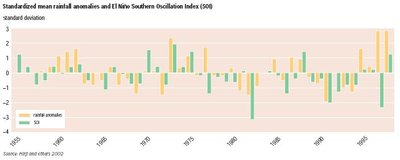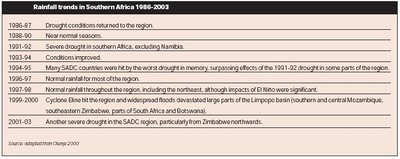Southern Africa and the atmosphere
| Topics: |
The atmosphere provides the supporting medium for human well-being and environmental goods-and-services. Its dynamism is characterized by seasonal and daily changes in temperature, rainfall and wind systems which shape human cultures, food production and the location of settlements, as well as the general state of the environment. Climate is the most important aspect of atmospheric phenomena. However, changes and variability in climate patterns in Southern Africa in the form of changes in rainfall patterns, rising temperatures and the increased frequency of extreme weather events such as droughts, floods and tropical cyclones, have farreaching impacts on socioeconomic development and human well-being.
The monthly variation in temperature is gradual, with the peak of the rainy season occurring between December and March. During this period, surface temperatures are warmest over the desert areas of Botswana and Namibia and exceed 26°C; relatively cooler conditions prevail over the central parts and also to the southeast where temperatures may be less than 20°C as a result of the cloudiness associated with summer rains. In the dry winter, the temperatures are cooler; the coldest areas, stretching from Lesotho through South Africa and to the southern tip of Namibia, experience temperatures averaging less than 14°C.
Rainfall is the most critical factor for livestock and crop production in the arid and semi-arid lands (ASAL). Generally, rainfall increases towards the equator, resulting in more rain in Tanzania, northern Mozambique and Angola, and less in South Africa, Botswana and Namibia. Rainfall is generally seasonal. Some important determinants of rainfall patterns include the Inter-Tropical Convergence Zone (ITCZ), the Botswana Upper High and the El Niño phenomenon. The ITCZ migrates seasonally over Africa, in response to the position of the sun, and its arrival leads to substantial rainfall amounts; it is responsible for most of the rainfall in the sub-region. A middle-level atmospheric condition, known as the Botswana Upper High, occurs from time to time and is inimical to rainfall activity in its vicinity. The persistent occurrence of the Botswana Upper High results in drought. The El Niño phenomenon is thought to decrease Southern Africa’s rainfall. During most El Niño episodes, the bulk of Southern Africa is likely to experience drought conditions while during a La Niña, there are chances of higher than normal rainfall. However, the relationship between the El Niño and rainfall anomalies sometimes breaks down, as happened in the 1986/87 and 1997/98 seasons.
The most common indicator of climate variability is the amount of rainfall received over the years, and year-to-year rainfall variability is high. The most critical variations are manifested as droughts, floods and tropical cyclones. Droughts have occurred periodically in Southern Africa throughout recorded history. Serious droughts have afflicted the sub-region in 1986-87, 1991-92, 1994-95 and 2001-2003. The droughts of the 1980s and 1990s have had a marked negative impact. For instance, the water level of the Kariba Dam on the Zambezi River dropped by 11.6 metres between 1981 and 1992, resulting in a reduction of the dam’s capacity to generate hydropower.
In addition to droughts, Southern Africa experiences exceptionally wet seasons resulting in extensive flooding. Most flooding is associated with active cyclones that develop in the Indian Ocean. The 1999-2001 rainfall seasons were dominated by active tropical cyclonic activity, which caused considerable human suffering. Tropical cyclone Eline had the most devastating effects during this period. As a result of cyclone Eline, heavy rains were experienced over southern Mozambique, parts of South Africa’s Limpopo Province and southeastern Zimbabwe, with over 200 mm of rain recorded over periods of less than 48 hours at many weather stations.
Apart from these vagaries of nature, climate change poses a serious threat: records have revealed temperatures to rise by over 0.5°C over the past 100 years and the 1990s were the warmest ever. There are also concerns about the possible negative impacts of sea-level rise. Climate models project an increase in global mean surface temperature of about 1-3.5°C by 2100 and an associated increase in sea level of about 15-95 cm. Crop yields are expected to be affected, dropping by as much as 10-20 percent in some parts of the subregion. It is also predicted that the malaria-carrying anopheles female mosquito will spread to parts of Namibia and South Africa where it has not been found before.
Addressing the threats associated with climate change demands new levels of research. Technological investment is an important aspect of responses, and partnerships with the international community can support this. The opportunity offered by carbon trading, by forestation and reforestation should be captured.
The Southern African Development Community Drought Monitoring Centre (SADC-DMC) was established in 1991 with the main objective of minimizing the negative impacts of climatic extremes on socioeconomic development in the sub-region. This is achieved through the monitoring of near real-time climatic trends and generating long-range climate outlook products on monthly and seasonal (up to six months) time scales. These outlook projections are disseminated to the sub-regional community to afford greater opportunity to decision-makers for the development of strategic plans.
The SADC Regional Early Warning System, in conjunction with the Famine Early Warning System and SADC-DMC, is providing advisory services regarding the status of the food security situation. Such systems have been useful in informing national and regional policies, forming the basis for food aid requests, as well as laying the foundation for land and agrarian reforms. Recently, there have been further efforts in Southern Africa to develop long-lead climate forecasting based on tropical sea surface temperature conditions. In order to maximize the benefits of advances in climate prediction, Southern Africa has demonstrated a need for a sub-regional climate network, which would meet regularly, interpret global and regional climate signals, and provide seasonal rainfall forecasts. This is currently done through the Southern Africa Regional Climate Outlook Forum (SARCOF) process, which advises on the likely status of the rainfall season before its onset.
Climate change and variability are global issues, requiring concerted international efforts. The global nature of these atmospheric phenomena presents a great challenge as it is difficult to reach international consensus on appropriate solutions and levels of responsibility. Some countries may find no direct value in addressing climate change and variability issues since their contribution to the phenomena is minimal. There is, therefore, a need to increase awareness on the affects of climate change.
The reliability of sub-regional predictions is still low, and the degree to which climate variability may change is uncertain. Given this, policymakers need to consider the value of taking precautionary measures by, for example, reducing GHG emissions and enhancing the resilience of vulnerable systems.
Further reading
- Chenje, M. and Johnson, P. (ed. 1996). State of the Environment in Southern Africa. Southern African Research and Documentation Centre, IUCN – The World Conservation Union, and Southern African Development Community. Johannesburg.
- Chenje, M. (ed. 2000). State of the Environment Zambezi Basin 2000. Southern African Development Community, IUCN – The World Conservation Union, Zambezi River Authority, Southern African Research and Documentation Centre, Maseru/Lusaka/Harare.
- DMC (undated). Atlas Southern Africa.
- Hoffmann, H.B., 2000. Linkages between climate change and desertification: Opportunities of an integrated approach. GLOBE Southern Africa Newsletter 2, March-April 2000.
- UN, 2003. UN Atlas of the Oceans: Climate Change and Vulnerability. United Nations, Geneva.
- UNEP, 2006. Africa Environment Outlook 2
- Watson, R.T., Zinyowera, M.C., and Moss, R.H. (eds. 1998). The Regional Impacts of Climate Change – An Assessment of Vulnerability.A Special Report of the Intergovernmental Panel on Climate Change Working Group II. Cambridge University Press, Cambridge.
- WWF-Nepal, 2005. An Overview of Glaciers, Glacier Retreat, and Subsequent Impacts in Nepal, India and China. Regional Overview – Executive Summary.
- Zöckler, C. and Lysenko, I., 2000. Water Birds on the Edge. First circumpolar assessment of climate change impact on Arctic Breeding Water Birds. World Conservation Monitoring Centre.
|
|
| Disclaimer: This article is taken wholly from, or contains information that was originally published by, the United Nations Environment Programme. Topic editors and authors for the Encyclopedia of Earth may have edited its content or added new information. The use of information from the United Nations Environment Programme should not be construed as support for or endorsement by that organization for any new information added by EoE personnel, or for any editing of the original content. |

